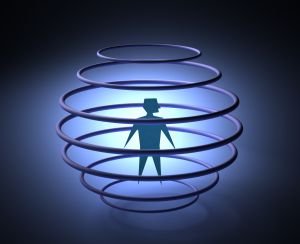An Exquisite Irony
The truth is cruel, but it can be loved,
and it makes free those who love it.
–George Santayana
As you follow the Enlightened Path, you will discover the truth about how you react to the things that happen, and how your responses contribute to the unfolding of objective reality. Reviewing your history and how you have contributed to it is a cruel assignment. Nevertheless, accepting the truth can set you free.
We are creatures that experience pain. It is understandable that we want to avoid suffering, and, when we fail to avoid it, that we seek relief. Fear, desire, anger, and other emotions are natural reactions of bio-psycho-social creatures to the things that happen. The more intense the emotion, the more it distorts state-dependent phenomena such as. perception, motivation, and response tendencies. Consequently, during crises — when good performance is critical — powerful emotional states make relapse more likely.
The Irony of trying too hard
Any intention evokes Doing Mode — that is, every goal comes with the motivation to achieve that goal, and sets the stage for ongoing evaluation of success and failure so you can make adjustments. Ironically, the greater your desire to achieve a certain goal the greater your emotional reactions to successes and failures, and hence the greater your state-dependent distortions. To the extent that successful performance depends upon clear thinking, dispassionate loyalty to the truth is more important than local success and failure. But how can you free yourself from attachment to outcomes when the stakes are high?
The goal to free yourself of childish passions sets up an interesting puzzle. Emotional reactivity and self-evaluation are attributes of the mentality of childhood. It takes an investment of energy to change these attributes, and you will have to continually evaluate how you are doing, so you can learn from your experience. So far so good. The fatal problem emerges if you react emotionally, which is usually the consequence of confusing the failure of a method with the failure of the self.
The Serenity Prayer
The Enlightened Path requires that you be open to the truth, no matter how ugly or cruel. Discovering the truth about cause-and-effect — rather than seeking relief from it or avoiding looking at it — is what enables you to benefit from the lessons that nature is trying to teach you. Judgmental reactions — especially those regarding you, your worth, goodness, competence, etc. — are the bait of the Failure Trap. The Serenity Prayer offers excellent guidance on how to prevent ruminative self-focus from hijacking your cognitive resources.
“Grant me the serenity to accept the things I cannot change, the courage to change the things I can, and the wisdom to know the difference,” is an eloquent statement of the Enlightened Path. The key to it is the wisdom of Epictetus [see Attachment]: The things you can change are your thoughts and actions. Demanding heroic performance from yourself is always appropriate, but you must remember that you do not control outcomes. Emotional reactions to the things that happen are not just pointless, they are self-sabotaging.
Events (including the responses of other people) that unfold in ways that make you unhappy can elicit anger, frustration and other negative emotional states. This is an adaptive reaction when the discomfort motivates problem-solving, but maladaptive to the extent that your emotional reaction evokes state-dependent distortions and drains cognitive resources. The greater the desire for the goal, the stronger the emotion if you don't get it (and even if you do), and, the greater the impairment of function.
Remember, our goal is to maximize your ability to get the good stuff in life (as you define it) and minimize the bad. Naturally, you will encounter your share of bad luck and failure along the path ahead. Your challenge is to train the creature you inhabit to cope with the raw experience of living a life so that you can perform well at times when doing so is particularly important.
